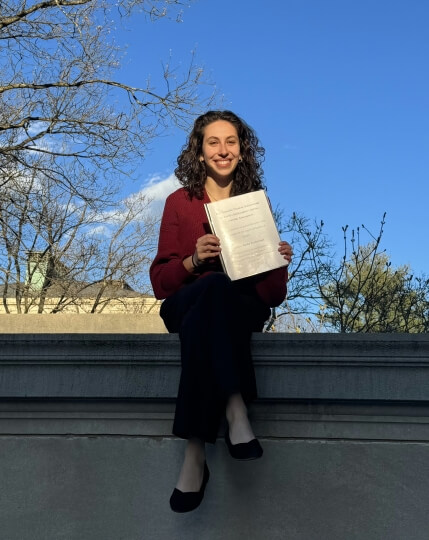For a senior capstone project, Emma Zuckerman designed a sensor to measure forward air speed in environments such as Earth’s stratosphere and the Martian atmosphere.
Engineering Design Projects (ES 100), the capstone course at the Harvard John A. Paulson School of Engineering and Applied Sciences (SEAS), challenges seniors to engineer a creative solution to a real-world problem.
Low Reynolds Number Anemometer for Earth’s Stratosphere and the Martian Atmosphere
Emma Zuckerman, S.B. '24, Mechanical Engineering
Advisor: Craig Mascarenhas
Please give a brief summary of your project.
I designed, built, and tested a sensor to measure forward air speed in environments with low Reynolds numbers, such as Earth’s stratosphere and the Martian atmosphere. Reynolds numbers measure and help predict fluid dynamics. Low Reynolds numbers occur when low air density couples with low wind speeds. Accurate wind velocity measurements at low Reynolds numbers would greatly improve the efficiency of operations and scientific value of data collected in Earth’s stratosphere and the Martian atmosphere. However, the standard method of recording precise wind velocity measurements provides unreliable results. The anemometer I designed is composed of a mechanical sensor tracked with computer vision, along with a novel wind flow enhancing scoop to accelerate wind flow and improve the signal to noise ratio for velocity measurements.
How did you come up with this idea for your final project?
I have been working in the Anderson Group for climate science at Harvard with my advisor Craig Mascarenhas since the summer after my freshman year. Through my lab, I learned about the lack of wind speed measurement technology in Earth’s stratosphere and the Martian atmosphere.
Is there a real-world challenge that this project addresses?
A low Reynolds number anemometer is a critical device for high-altitude propelled balloons to assess climate risks in the stratosphere and for Martian rovers to investigate signs of life. The anemometer that I designed is currently being integrated onto a high-altitude propelled balloon test flight in the stratosphere sponsored by the Harvard Keutsch Lab scheduled for this June in New Mexico.
What was the timeline of your project?
I began working on the anemometer design last fall and then started building and testing the device this spring. I am now continuing to work on the anemometer to electrically and mechanically integrate the design onto the high-altitude propelled balloon test fight.
What part of the project proved the most challenging?
One of the most challenging parts was designing the methods for testing and verification. I wasn’t able to test the anemometer in the stratosphere, so instead I tested in a wind tunnel at surface level conditions and utilized Reynolds number and dynamic pressure scaling to verify the accuracy of the device at stratospheric conditions. Verifying accuracy from surface level conditions to stratospheric conditions was more difficult than I expected.
What part of the project did you enjoy the most?
I enjoyed designing the computer vision algorithm to detect wind speed. My algorithm integrated mathematical concepts from my physics and mechanics classes. I enjoyed applying these concepts to a very real-world problem in a creative way. It was also rewarding to test the final product and watch my device accurately measure wind speeds.
What did you learn, or skills did you gain, through this project?
My project involved skills from various fields, including mechanical engineering for designing the velocity sensor, electrical engineering for programming the computer vision algorithm, and computational fluid dynamics to model the airflow through the device. Prior to beginning this project, I had never done computer vision or computational fluid dynamics, but by the end of my project I was comfortably using software and a computer vision library. I now feel much more confident in my ability as an engineer to quickly pick up new skills.
Press Contact
Matt Goisman | mgoisman@g.harvard.edu
